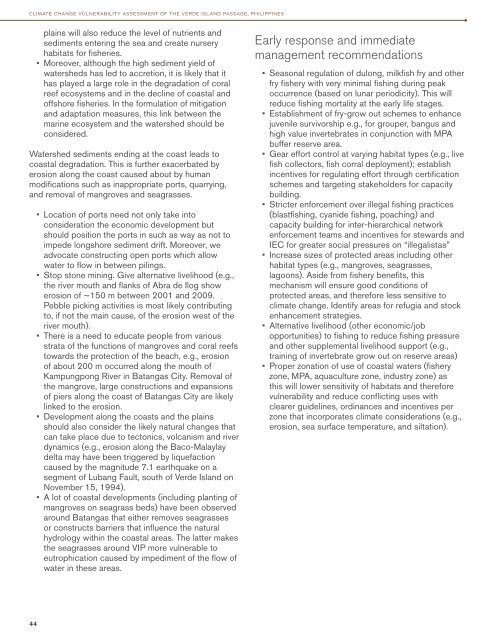of the Verde Island Passage, Philippines - weADAPT
of the Verde Island Passage, Philippines - weADAPT
of the Verde Island Passage, Philippines - weADAPT
You also want an ePaper? Increase the reach of your titles
YUMPU automatically turns print PDFs into web optimized ePapers that Google loves.
climate change vulnerability assessment <strong>of</strong> <strong>the</strong> verde island passage, philippines<br />
plains will also reduce <strong>the</strong> level <strong>of</strong> nutrients and<br />
sediments entering <strong>the</strong> sea and create nursery<br />
habitats for fisheries.<br />
• Moreover, although <strong>the</strong> high sediment yield <strong>of</strong><br />
watersheds has led to accretion, it is likely that it<br />
has played a large role in <strong>the</strong> degradation <strong>of</strong> coral<br />
reef ecosystems and in <strong>the</strong> decline <strong>of</strong> coastal and<br />
<strong>of</strong>fshore fisheries. In <strong>the</strong> formulation <strong>of</strong> mitigation<br />
and adaptation measures, this link between <strong>the</strong><br />
marine ecosystem and <strong>the</strong> watershed should be<br />
considered.<br />
Watershed sediments ending at <strong>the</strong> coast leads to<br />
coastal degradation. This is fur<strong>the</strong>r exacerbated by<br />
erosion along <strong>the</strong> coast caused about by human<br />
modifications such as inappropriate ports, quarrying,<br />
and removal <strong>of</strong> mangroves and seagrasses.<br />
• Location <strong>of</strong> ports need not only take into<br />
consideration <strong>the</strong> economic development but<br />
should position <strong>the</strong> ports in such as way as not to<br />
impede longshore sediment drift. Moreover, we<br />
advocate constructing open ports which allow<br />
water to flow in between pilings.<br />
• Stop stone mining. Give alternative livelihood (e.g.,<br />
<strong>the</strong> river mouth and flanks <strong>of</strong> Abra de Ilog show<br />
erosion <strong>of</strong> ~150 m between 2001 and 2009.<br />
Pebble picking activities is most likely contributing<br />
to, if not <strong>the</strong> main cause, <strong>of</strong> <strong>the</strong> erosion west <strong>of</strong> <strong>the</strong><br />
river mouth).<br />
• There is a need to educate people from various<br />
strata <strong>of</strong> <strong>the</strong> functions <strong>of</strong> mangroves and coral reefs<br />
towards <strong>the</strong> protection <strong>of</strong> <strong>the</strong> beach, e.g., erosion<br />
<strong>of</strong> about 200 m occurred along <strong>the</strong> mouth <strong>of</strong><br />
Kampungpong River in Batangas City. Removal <strong>of</strong><br />
<strong>the</strong> mangrove, large constructions and expansions<br />
<strong>of</strong> piers along <strong>the</strong> coast <strong>of</strong> Batangas City are likely<br />
linked to <strong>the</strong> erosion.<br />
• Development along <strong>the</strong> coasts and <strong>the</strong> plains<br />
should also consider <strong>the</strong> likely natural changes that<br />
can take place due to tectonics, volcanism and river<br />
dynamics (e.g., erosion along <strong>the</strong> Baco-Malaylay<br />
delta may have been triggered by liquefaction<br />
caused by <strong>the</strong> magnitude 7.1 earthquake on a<br />
segment <strong>of</strong> Lubang Fault, south <strong>of</strong> <strong>Verde</strong> <strong>Island</strong> on<br />
November 15, 1994).<br />
• A lot <strong>of</strong> coastal developments (including planting <strong>of</strong><br />
mangroves on seagrass beds) have been observed<br />
around Batangas that ei<strong>the</strong>r removes seagrasses<br />
or constructs barriers that influence <strong>the</strong> natural<br />
hydrology within <strong>the</strong> coastal areas. The latter makes<br />
<strong>the</strong> seagrasses around VIP more vulnerable to<br />
eutrophication caused by impediment <strong>of</strong> <strong>the</strong> flow <strong>of</strong><br />
water in <strong>the</strong>se areas.<br />
Early response and immediate<br />
management recommendations<br />
• Seasonal regulation <strong>of</strong> dulong, milkfish fry and o<strong>the</strong>r<br />
fry fishery with very minimal fishing during peak<br />
occurrence (based on lunar periodicity). This will<br />
reduce fishing mortality at <strong>the</strong> early life stages.<br />
• Establishment <strong>of</strong> fry-grow out schemes to enhance<br />
juvenile survivorship e.g., for grouper, bangus and<br />
high value invertebrates in conjunction with MPA<br />
buffer reserve area.<br />
• Gear effort control at varying habitat types (e.g., live<br />
fish collectors, fish corral deployment); establish<br />
incentives for regulating effort through certification<br />
schemes and targeting stakeholders for capacity<br />
building.<br />
• Stricter enforcement over illegal fishing practices<br />
(blastfishing, cyanide fishing, poaching) and<br />
capacity building for inter-hierarchical network<br />
enforcement teams and incentives for stewards and<br />
IEC for greater social pressures on “illegalistas”<br />
• Increase sizes <strong>of</strong> protected areas including o<strong>the</strong>r<br />
habitat types (e.g., mangroves, seagrasses,<br />
lagoons). Aside from fishery benefits, this<br />
mechanism will ensure good conditions <strong>of</strong><br />
protected areas, and <strong>the</strong>refore less sensitive to<br />
climate change. Identify areas for refugia and stock<br />
enhancement strategies.<br />
• Alternative livelihood (o<strong>the</strong>r economic/job<br />
opportunities) to fishing to reduce fishing pressure<br />
and o<strong>the</strong>r supplemental livelihood support (e.g.,<br />
training <strong>of</strong> invertebrate grow out on reserve areas)<br />
• Proper zonation <strong>of</strong> use <strong>of</strong> coastal waters (fishery<br />
zone, MPA, aquaculture zone, industry zone) as<br />
this will lower sensitivity <strong>of</strong> habitats and <strong>the</strong>refore<br />
vulnerability and reduce conflicting uses with<br />
clearer guidelines, ordinances and incentives per<br />
zone that incorporates climate considerations (e.g.,<br />
erosion, sea surface temperature, and siltation).<br />
44
















